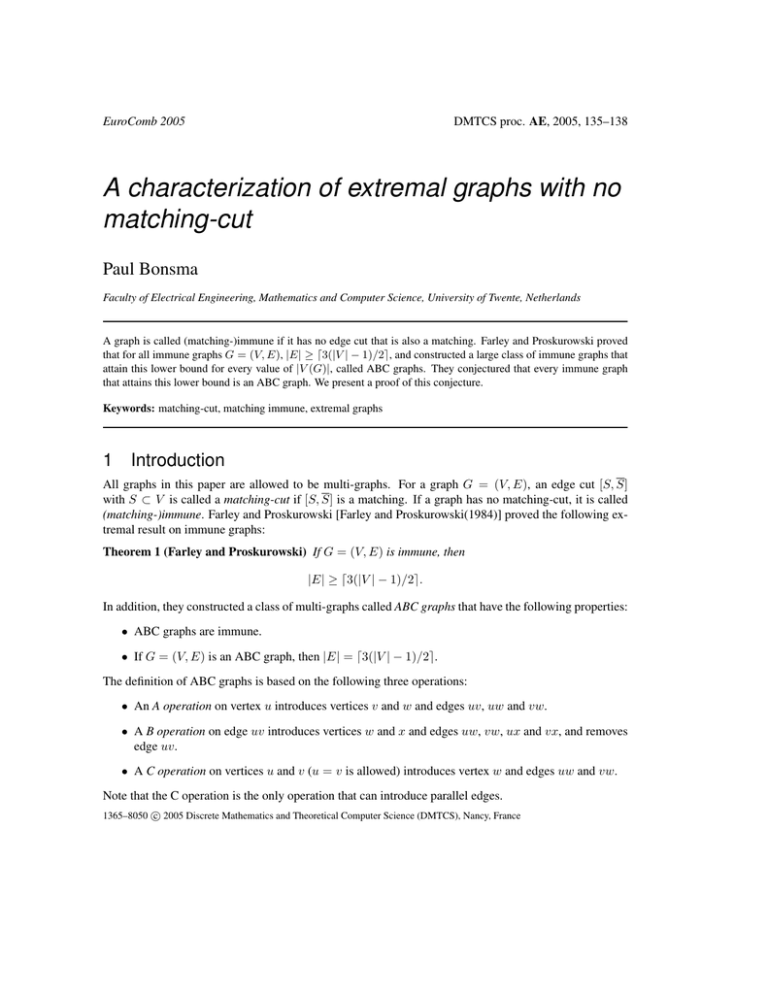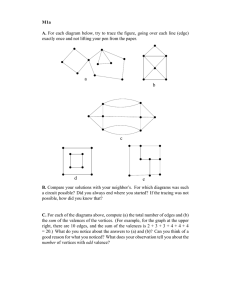A characterization of extremal graphs with no matching-cut Paul Bonsma EuroComb 2005
advertisement

DMTCS proc. AE, 2005, 135–138
EuroComb 2005
A characterization of extremal graphs with no
matching-cut
Paul Bonsma
Faculty of Electrical Engineering, Mathematics and Computer Science, University of Twente, Netherlands
A graph is called (matching-)immune if it has no edge cut that is also a matching. Farley and Proskurowski proved
that for all immune graphs G = (V, E), |E| ≥ d3(|V | − 1)/2e, and constructed a large class of immune graphs that
attain this lower bound for every value of |V (G)|, called ABC graphs. They conjectured that every immune graph
that attains this lower bound is an ABC graph. We present a proof of this conjecture.
Keywords: matching-cut, matching immune, extremal graphs
1
Introduction
All graphs in this paper are allowed to be multi-graphs. For a graph G = (V, E), an edge cut [S, S]
with S ⊂ V is called a matching-cut if [S, S] is a matching. If a graph has no matching-cut, it is called
(matching-)immune. Farley and Proskurowski [Farley and Proskurowski(1984)] proved the following extremal result on immune graphs:
Theorem 1 (Farley and Proskurowski) If G = (V, E) is immune, then
|E| ≥ d3(|V | − 1)/2e.
In addition, they constructed a class of multi-graphs called ABC graphs that have the following properties:
• ABC graphs are immune.
• If G = (V, E) is an ABC graph, then |E| = d3(|V | − 1)/2e.
The definition of ABC graphs is based on the following three operations:
• An A operation on vertex u introduces vertices v and w and edges uv, uw and vw.
• A B operation on edge uv introduces vertices w and x and edges uw, vw, ux and vx, and removes
edge uv.
• A C operation on vertices u and v (u = v is allowed) introduces vertex w and edges uw and vw.
Note that the C operation is the only operation that can introduce parallel edges.
c 2005 Discrete Mathematics and Theoretical Computer Science (DMTCS), Nancy, France
1365–8050 136
Paul Bonsma
C2:
C3:
C4:
P2:
Fig. 1: The four reduction operations
Definition 1 An ABC graph is a graph that can be obtained from K1 with a sequence of A and B operations and at most one C operation.
A sequence of these operations that constructs a graph G from a graph H is called a decomposition of G
from H, or simply a decomposition of G if H = K1 . For every integer n ≥ 1, an ABC graph exists. For
every integer n ≥ 1, n 6= 2, a simple ABC graph exists. This shows that the lower bound from Theorem 1
is tight. This inspires the following definition:
Definition 2 A graph G = (V, E) is called extremal immune if |E| = d3(|V | − 1)/2e and G is immune.
Farley and Proskurowski stated the following conjecture:
Conjecture 2 (Farley and Proskurowski) If a graph G is extremal immune, then G is ABC.
In this paper, we sketch our proof of this conjecture, and show some of the techniques that are used. First
we will go into more detail on Farley and Proskurowski’s proof of Theorem 1.
2
Contraction operations
To prove Theorem 1, Farley and Proskurowski [Farley and Proskurowski(1984)] introduce four graph
operations, named after the structure they reduce. These operations are explained in Figure 1. Below
are formal definitions, which show that all of these operations can be expressed with edge deletions and
contractions. C2 stands for the cycle of length two, which is a multi-graph.
C2 Let vertices u and v induce a C2 in graph G. The C2 operation consists of deleting one of the edges
of this C2 and contracting the other.
C3 Let vertices u, v and w induce a C3 in G. The C3 operation consists of deleting uv and contracting
vw and wu.
C4 Let vertices u, v, w and x induce a C4 in G such that uw 6∈ E(G). The C4 operation consists of
deleting uv and contracting ux and vw. Note that for one induced C4 the C4 operation can be
applied in two different ways.
P2 Let vertices u and v be neighbors in G with d(u) = 3 and d(v) = 2. Let v have another neighbor
z 6= u, and let u have another neighbor x 6= v. The P2 operation consists of deleting uv and
contracting ux and vz.
A characterization of extremal graphs with no matching-cut
137
It can be checked that these four operations have the following properties:
Lemma 3 (Farley and Proskurowski) Suppose G0 can be obtained from G by a C2, C3, C4 or P2 operation. Then:
• If G is immune, then G0 is immune.
• If |E(G)| = d3(|V (G)| − 1)/2e, then |E(G0 )| ≤ d3(|V (G0 )| − 1)/2e. This inequality is always an
equality for the C3, C4 and P2 operation.
To prove Theorem 1, the following lemma was used:
Lemma 4 (Farley and Proskurowski) If G is an extremal immune graph not equal to K1 , then one of
the operations C2, C3, C4 or P2 can be applied to G.
On this lemma our proof of Conjecture 2 is based.
3
Overview of the proof
The proof of Conjecture 2 is by contradiction, so first we assume an extremal immune graph exists that is
not an ABC graph. Then we consider a graph with minimum number of vertices among all such graphs.
This explains the following definition:
Definition 3 A graph G is a minimum counterexample if it is extremal immune, it is not an ABC graph,
and has minimum number of vertices among all such graphs.
We first consider the case that a minimum counterexample G contains a C2 , so a C2 operation can be
applied, resulting in vertex v. After applying this C2 operation, another extremal indecomposable graph
G0 is obtained (Lemma 3, Theorem 1). By our choice of G, G0 must be an ABC graph. We consider a
number of cases for G0 , for the choice of v ∈ V (G0 ) and for the possible graphs G that can correspond to
this, and in every case we obtain one of the following contradictions: G has a matching-cut, G is also an
ABC graph, or a smaller counterexample exists.
If a minimum counterexample G contains a triangle, we can apply operation C3 and find a contradiction
in a similar way, and if G contains a C4 , applying a C4 operation leads to a contradiction. Finally, we can
show that if a P2 operation can be applied resulting in the ABC graph G0 , then there is always a triangle
or C4 in G0 that corresponds to a triangle or C4 in G, so the previous cases can be applied. Since every
operation leads to a contradiction, Lemma 4 shows that no counterexamples for the conjecture can exist.
4
The structure of ABC graphs
Definition 4 A graph G that can be obtained from a graph H using only B operations is called an Hcomponent.
These graphs will often be used for H in this case:
K2 A K2 -component G is also called an edge component. If G can be constructed from a K2 on vertices
u and v, then G is called an edge component between u and v.
C3 A C3 -component is also called a triangle component.
138
Paul Bonsma
We can partition the edges of ABC graphs into edge induced components that are all H-components for
H = C3 , C2 or P3 , where C3 -components correspond to A operations in the decomposition, and the C
operation corresponds to a C2 or P3 -component:
Observation 5 For any decomposition of ABC graph G using k A operations, we can partition the edges
of G into sets A1 , . . . , Ak and at most one set C such that for every i, G[Ai ] is a triangle component, and
G[C] is a C2 or P3 -component.
Observation 6 For any decomposition of an H-component G, we can partition E(G) into sets {Euv :
uv ∈ E(H)} such that G[Euv ] is an edge component between u and v. u and v are the only vertices of
G[Euv ] that can be incident with other edges in G.
Lemma 7 For every edge component G between u and v, and every edge e ∈ E(G), a matching-cut M
exists that separates u from v with e ∈ M .
Lemma 8 If u is a vertex in a triangle component T , then a decomposition of T exists that starts on u.
5
An example case
Consider the case that minimum counterexample G contains a triangle on vertices u1 , u2 and u3 , and a
C3 operation on this triangle yields ABC graph G0 that consists of a single triangle component. Vertex
u ∈ V (G0 ) corresponds to the contracted triangle.
Edges of G0 correspond to edges of G, since the C3 operation consists of contraction and edge deletion
operations. G[M ] denotes the graph induced by the edges of G that correspond to M ⊂ E(G0 ) this way.
If G[E(G0 )] is isomorphic to G0 , then all edges incident with u ∈ V (G0 ) must w.l.o.g. be incident with
u1 ∈ V (G). In this case, G can be obtained from G0 with a single A operation on u introducing u2 and
u3 , and renaming u as u1 . So G is an ABC graph in this case, a contradiction.
Now suppose G[E(G0 )] is not isomorphic to G0 . By Lemma 8, we know that a decomposition of
0
G exists that starts with vertex u. Suppose the first A operation introduces vertices v and w. Now the
edges of G0 can be partitioned into edge components Fuv , Fuw and Fvw that correspond to the edges
introduced in this first A operation (Observation 6). Since G[E(G0 )] is not isomorphic to G0 , it follows
that there are edges e ∈ E(Fuv ) and f ∈ E(Fuw ) that are both incident with u in G0 , but that correspond
w.l.o.g. to edges incident with u1 resp. u2 in G. Since G0 is a simple graph, e and f therefore correspond
to non-adjacent edges in G. Now consider a matching-cut M1 in Fuv that separates u from v, such
that e ∈ M1 , and a matching-cut M2 in Fuw that separates u from w, such that f ∈ M2 (Lemma 7).
Using Observation 6, it can be checked that M1 ∪ M2 corresponds to a matching-cut in G, which is a
contradiction.
Acknowledgements
The author would like to thank Andrzej Proskurowski and Hajo Broersma for their suggestions and the
discussions on this subject.
References
[Farley and Proskurowski(1984)] A. M. Farley and A. Proskurowski. Extremal graphs with no disconnecting matching. In Proceedings of the second West Coast conference on combinatorics, graph
theory, and computing (Eugene, Ore., 1983), volume 41, pages 153–165, 1984.





